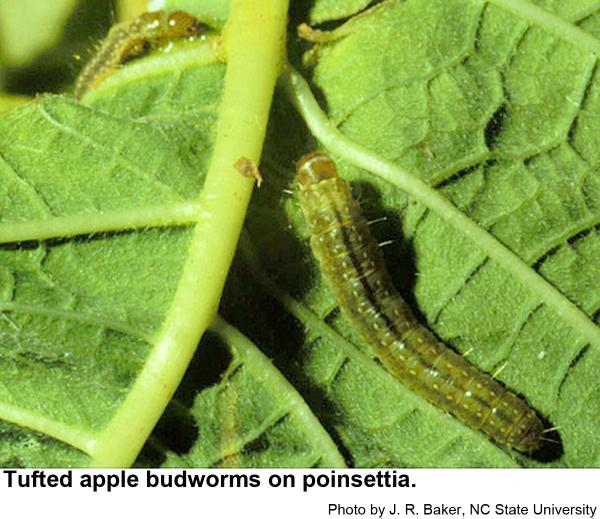Description and Biology
The tufted apple budworm moth, Platynota idaeusalis, is gray with reddish brown to dark brown markings and about 1/2 inch long. The hindwings are grayish brown to dark brown. It is called tufted because it has tufts of dark, raised scales on the fore wings. These moths have noticeable "snouts" (the labial palps) that are as long as the head and thorax combined. Tufted apple budworm caterpillars grow to about 5/8 inch and are green to brownish green. The head and the patch just behind the head are brown to dark brown, and the head is mottled. This species has a comb-like structure with five to eight teeth just above the anus. We have two generations per year. Tufted apple budworm moths are in flight from May to July and again in August to September. Females lay eggs in masses of about 100 eggs on the upper surface of leaves. Young caterpillars spin silk webbing under which they feed on the underside of a leaf usually along the midrib. Later instars feed within rolled, folded, or tied leaves. They pupate in a folded or rolled leaf. Tufted apple budworms overwinter as diapausing caterpillars in leaf litter. Increasing daylengths and warmer temperatures induce the caterpillars to molt into pupae. A new generation of moths emerges 6 to 28 days later.
Host plants
The tufted apple budworm is a pest of apple, but also infests plants in at least 13 families including Euphorbiaceae (poinsettia). Ash, birch, blackberry, blackhaw, black walnut, blueberry, clover, dogwood, goldenrod, grape, ironweed, jack pine, leather flower, nightshade, osage orange, peach, raspberry, willow, are some of its other host plants. Evidently they are general feeders.
Residential Recommendations
Because tufted apple budworms usually hide in their webbing, it would be best to use a pyrethroid insecticide because pyrethroids have a long residual life. (Pyrethroids labeled for residential landscapes are available in the garden section of big box stores and in nurseries and plant centers.) When the budworms emerge from their webbing to cut leaves and drag them back to feed, they then encounter the pesticide residue on the leaf fragments if the pesticide has a long enough residual life (most pyrethroids do).
Other Resources
- Diapause in Platynota idaeusalis (Lepidoptera: Tortricidae): Effects of Temperature, Photoperiod, and Time of Inoculation in the Field on Diapause Termination. Boyne J. V, et al. 1985. Environmental Entomology14(6): 790–796.
- Larvae of the North American Tortricinae (Lepidoptera: Tortricidae). MacKay, M. R. 1962. The Canadian Entomologist Supplement 28: 1-182.
- The bionomics of the tufted apple budmoth, Platynota idaeusalis in Michigan. Hogmire, H. W. and A. J. Howitt. 1979. Annals of the Entomological Society of America. 72: 121-126.
- Platynota idaeusalis. Tortricids of Agricultural Importance. Gilligan T. M. and M. E. Epstein. 2014 (update). Colorado State University.
- Tortricid fauna of apple in New York (Lepidoptera: Tortricidae); including an account of apple's occurrence in the state, especially as a naturalized plant. Chapman, P. J. and S. E. Lienk. 1971. Spec. Publ. Geneva, NY: New York State Agricultural Experiment Station. 122 pp.
- Extension Plant Pathology Publications and Factsheets
- Horticultural Science Publications
- North Carolina Agricultural Chemicals Manual
For assistance with a specific problem, contact your local N.C. Cooperative Extension Center.
This Factsheet has not been peer reviewed.
Publication date: Jan. 21, 2019
Revised: Nov. 4, 2023
Recommendations for the use of agricultural chemicals are included in this publication as a convenience to the reader. The use of brand names and any mention or listing of commercial products or services in this publication does not imply endorsement by NC State University or N.C. A&T State University nor discrimination against similar products or services not mentioned. Individuals who use agricultural chemicals are responsible for ensuring that the intended use complies with current regulations and conforms to the product label. Be sure to obtain current information about usage regulations and examine a current product label before applying any chemical. For assistance, contact your local N.C. Cooperative Extension county center.
N.C. Cooperative Extension prohibits discrimination and harassment regardless of age, color, disability, family and marital status, gender identity, national origin, political beliefs, race, religion, sex (including pregnancy), sexual orientation and veteran status.


